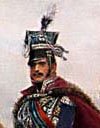 |
| Austrian Napoleonic Shakos illustrated by the Funkens |
This post will cover the whole of the process with some summary photos.
After cleaning off the flashing and fixing the errors from the castings, and in this case the Old Glory Austrian Dragoons Charging had separate arms that had to be glued into place, then using green stuff to fill in the gaps.
The minis were then attached to metal fender washers, which is how they get magnetized to the sheet steel bases that I use. They were then attached to painting sticks, using watered down white glue, this allows me to handle the minis without touching the bases. I also keep the same poses together, so this makes the detail and other painting go much faster.
As this set had cavalry, I use folded cardboard (cut from cereal boxes) to stick the riders onto. Again so that I can handle them without touching the actual rider minis, and to permit me to be really sloppy with the watered down paint or inks that I use on my horses. The riders are painted separately, and shabraques in the case of the Old Glory ones, so that the time and care on faces and equipment can be done. Then just before the gloss coating they are glued together.
 |
| The stages of development of the horse |
 |
| The stages of development of the riders |
Then work began in concert, the white was also done on the Old Glory shabraques and any section that was going to later be painted red. Then the reds were done and block colors of the uniforms, mostly green, though the Cuirassier were done in my usual white pattern of first decreasing shades of blue fading to white highlights. This same fading blue was done with the many cross-belts.
Finally the yellow was done on the many places of lace and borderings and the lance pennons of the Uhlans.
 |
| Riders on the mounts after the gloss coat |
Then the riders were separated from the cardboard holders and glued onto their mounts.
The whole mass is left overnight to set.
The next day I had them out to gloss coat spray, then that evening, the 30th, I was doing the flocking.
 |
| all flocked and ready to go on the magnetic bases |
This force of cavalry and the Austrian Infantry I have worked on this year have yet to take to the tabletop as a force for a game ... with the weather co-operating maybe they can do their first battle as a Garden War?






















































4 comments:
Ha! I have been painting some Austrian cavalry as well! Some of the same regiments as well I think. I think I spied the ever-popular Hessen-Homburg hussars in one of your photos; they are a must have with those blue shakos!
I like your horse technique. They look a little strange at the beginning but are splendid at the end. Nice work!
Jim
Thank you Jim.
Yes the Hessen-Homburg Hussars were painted, mostly because they are the ones depicted in the Funken illustration.
I had the ones with the red Shakos painted before and sold them a few years ago. Decided to re-supply my Austrian army and now have the space set aside for keeping them.
Very nice work on the cavalry, nice to see their evolution.
I'm dubious about the shakos with the front and back visors. Aside from looking odd, I wonder if the rear-facing portion did any good at all in keeping sun off the neck or deflecting rain water.
Regards,
Steve
I think that the back section worked in concert with the upturned lapels of the greatcoats to keep rainwater out from the body.
Though I seem to recall a Knotel print depicting a cloth like element coming off the back of the shako, Similar to the French Foreign Legion helmets used in North Africa? Though I have also read tales of such helmets as being close to useless as they tend to trap the heat against the body and not permit it to properly 'breathe'.
Thank you for the comments!
Post a Comment